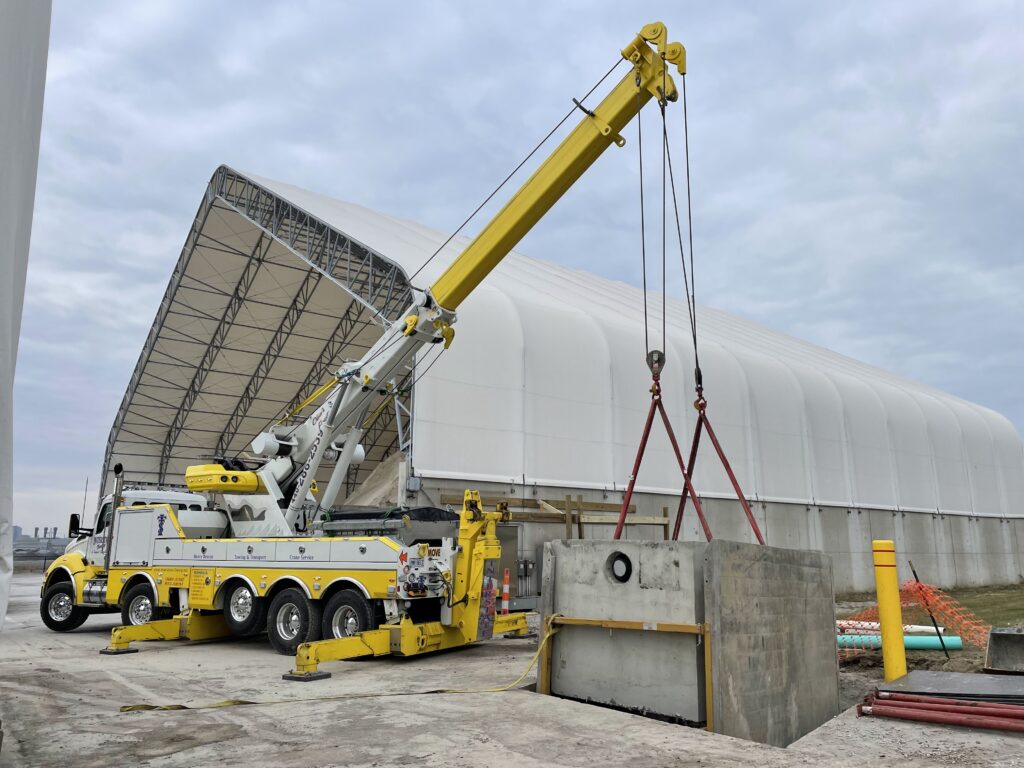Rigging Best Practices
Rigging Best Practices
Rigging is an inherently risky service that requires great attention to detail. The best rigging companies come prepared with a plan for every lift. To minimize risk, Interstate Towing & Transport identifies, addresses, and controls risks for each phase of an overhead lift. Here are some of the rigging best practices we follow.

Correct Rigging Best Practices
As a heavy rigging company, we never cut corners and always adhere to rigging best practices. This ensures that we are able to complete all overhead lifts with precision, accuracy, and safety.
1. Qualifications, Competencies, and Certifications Matter!
When it comes to providing industrial rigging services, only those who are competent, certified in, and assigned to the task of rigging are allowed to perform these duties. We have specialized responsibilities for each facet of the job, including inspecting the equipment, performing maintenance, and operating crane equipment.
2. Quality Equipment
Not only does Interstate Towing and Transport invest in the best and highest-quality equipment, we also regularly and diligently inspect this hardware. Deformities, cracks, stretches, nicks, gouges, and other imperfections are identified and dealt with immediately to prevent catastrophe. Our inspections cover shackles, turnbuckles, eye nuts, swivel hoist rings, wire rope clips, wedge sockets, links, rings, swivels, rigging blocks, and all other components.
3. Inspection of Lifting Slings
The American Society of Mechanical Engineers (ASME) sets standards for lifting and rigging. We follow guidance from AMSE B30.9 for inspection, testing, and maintenance of our wire rope slings, alloy chain slings, synthetic rope slings, metal mesh slings, synthetic web slings, and synthetic round slings. Each sling is inspected for integrity prior to being used.
4. Consider Rating and Working Load Limit
Working Load Limit (WLL) is defined as the maximum amount of mass or force that a certain piece of equipment is able to support. In determining the WLL, we only utilize components and attachments with the same strength materials and of equal WLL rating.
5. Calculate Total Load Weight
Prior to performing the overhead lift, Interstate Towing and Transport determines the weight of the load. The known weight of the load incorporates the weight of any accompanying slings, hardware, lifting beams, spreader bars, c-hooks, magnets, and other mechanisms.
6. Choose the Right Sling Type & Sling Hitch
Having the right sling type and sling hitch is essential for ensuring support and contact with the load at hand.
A vertical hitch utilizes a hook attached to the sling while the other end is connected to the load. Slings with a vertical hitch allow for full lifting capacity. Generally, we use more than one sling to avoid rotation or twisting. Vertical hitches are not used for loose or long materials as well as unbalanced loads.
Choker hitches incorporate a sling around one end of the load with the other end on a hook. Sometimes, a wood block may be placed between the hitch and load for optimal grip and angle of the choke. These are never used on loose bundles and we always ensure that the sling is long enough for efficiency of the choke.
A double-wrap choker hitch describes full, all-encompassing contact with the load to compress it and prevent slippage out of the sling. We never overlap slings at the bottom of the load.
Basket hitches consist of a sling cradling the load and attachment to both eyes overhead. Load control is maximized with the use of multiple slings and by avoiding this mechanism for off-balance loads.
7. Ensure Structural Integrity of Load & Remove Obstacles
Each and every load requires proper support and securement. Surrounding areas should be cleared of any obstructions that could impede lifting the load. We conduct a Job Site Analysis to identify these hazards and then control or eliminate them.
8. Calculate Proper Sling Angle
Sling angle is extremely important when performing overhead lifts - 90°, 60°, 45°, 30°. Smaller angles lessen the load that the sling can carry. We consult our rigging charts to determine the capacity of the sling we are using at any angle.
9. Determine the Load’s Center of Gravity
The load’s center of gravity denotes the point at which the load is balanced. The center of gravity is where the horizontal and vertical balance points meet. We ensure that the center of gravity is positioned below the load hook and that the connection is above the center of gravity.
10. Mind Your Distance to the Load
Spatial awareness is a critical aspect of overhead lifting. All individuals are kept out of striking distance of overhead loads while being lifted, maneuvered, and lowered. We keep all loads as low as possible. Only essential employees are allowed in the vicinity, with the entire crew in radio contact and line of sight as a lift is completed. All employees are accounted for after the lift.
11. Utilize Sling Protection
Without proper protection, slings are susceptible to cuts and damage which can lead to failure. Corner pads, guards, and sleeves prevent cuts and abrasions from corners and other surfaces. We pad all edges of the load as part of our standard rigging best practices.
12. Take Note of Environmental Conditions
Not each job site is the same. Conditions can vary and impact the overhead lift. Interstate Towing and Transport ccounts for extreme temperatures, wind, snow, ice, rain, chemical agents, elevation change, and other environmental factors.
13. Check Rigging Gear for Correct Identification
Each piece of rigging gear should be marked with proper identification. This includes the manufacturer name, working load limit, serial number, and other pertinent details.
Partner With an Industrial Rigging Company That Follows the Rules
Taking shortcuts is a sure way to bring danger into any situation, but particularly industrial rigging. For this reason, we strictly follow rigging best practices to make your job a success. For crane rental equipment, heavy rigging, heavy equipment and machinery moving, and more, contact Interstate Towing and Transport. We are here to help!


